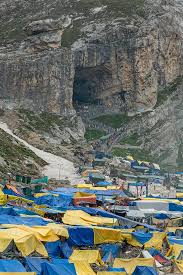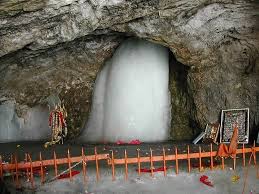The Ultimate Amarnath Yatra Guide: Tips, History, and Pilgrim Experiences
Amarnath Yatra Guide: Amarnath Cave situated in the Himalayas of Jammu and Kashmir in India is one of the most important pilgrimage sites in Hindu religion. This shrine is also located in Kashmir valley and is devoted to lord Shiva Thousands of pilgrims start a rigorous spiritual and physical journey of visit to the cave shrine is called Amarnath yatra. This paper offers a detailed analysis of Amarnath Cave and Yatra including historical, religious, and cultural background, evolution, and description of the Yatra and the routes with reference to the accounts of the pilgrims.
Historical Background
The history of Amarnath Cave is quite legendary and mythical; the legends associated with it have been described in the oldest Hindu texts. Traditional history has it that, the cave was found by a shepherd called Buta Malik in the 15th century AD but the references regarding this cave can be traced back to Nilamata Purana. It is believed that once Lord Shiva enlightened the myth of Maharshi Nara and Narayana and the legend of Amar Katha to his wife Goddess Parvati here.
Naturally, to maintain the secrecy of this revelation, Shiva dispelled with all his retinue and possessions, the Bull Nandi, Moon from his<head>, and Ganesha, his son, before he took Parvati to the cave. But, a male and female dove who overheard the secret were also made to be immortal as per the directions of Shiva. It is also common for pilgrims to claim they saw the doves inside the cave and it increases the ambiance of the place.
The Sacred Ice Lingam
In the center of the cave, there is automatically formed through ice-stuck Shiva’s organ known as lingam. This lingam is a kind of natural formation developing from water that drips from the roof of the cave and freezes once it touches the ground.
Notably, the lingam swells and subsides with phases of the moon and is at its largest during the monsoons, particularly in the Shravan(mid-July to mid-August). On both sides of the main lingam, there are two comparatively small forms of ice, which are Goddess Parvati and Lord Ganesha. It is believed to be a natural power that is a manifestation of the ‘collective spiritual consciousness’ and is a pilgrimage site where millions of people go for boons and spiritual comfort.
The Amarnath Yatra Guide
Amarnath Yatra as a Hindu pilgrimage is devotion, strength, and journey towards achievement of spirituality. The journey typically begins in the town of Pahalgam or Baltal, with two main routes available to pilgrims: The journey typically begins in the town of Pahalgam or Baltal, with two main routes available to pilgrims:
The Traditional Route via Pahalgam:The Traditional Route via Pahalgam:
Pahalgam to Chandanwari: A kind of prologue to the intense walking that one has to undertake through the Kokthong-Dungen Trail covering 16 kilometers in length. Chandanwari is beautiful and is most famous for camping.
Chandanwari to Sheshnag: An 11 km easier but steep walking trail that provides vantage views of the Himalayas. Labeled after the mythical serpent, Sheshnag is a high-altitude lake plan with mountains whose peaks are capped with snow.
Sheshnag to Panchtarni: A 13-kilometer walk which, crosses the Mahagunas Pass –the highest pass of the Yatra– standing at a height of 4,420 meters or 14,500 feet. Panchtarni is the final halt before the start of the steep climb to the cave situated in a valley of the same name.
Panchtarni to Amarnath Cave: It is a 6 km stretch up to the holy cave where devotees are allowed to pray and take the blessings.
The Shorter Route via Baltal to Amarnath Cave: A 14 km trek, this route is steeper and more challenging but significantly shorter, making it suitable for pilgrims with time constraints or those seeking a quicker path to the cave.
Preparations and Challenges
Considering the fact that the Yatra is held at high altitudes and the climate is quite enigmatic, and the topography quite rigid, planning for the Amarnath Yatra is a process that calls for rather serious preparation. Pilgrims must produce a medical fitness certificate and enable themselves to have their names in the registry of SASB. Appropriate clothing, such as warm layers, strong, and raincoats is especially needed. To prevent mile-high sickness or the potentially deadly acute mountain sickness, it is necessary to get used to the thinning air at higher elevations.
The trip is a roller coaster ride in part. Weather that occurs by the time pilgrims get an unpleasant cold front which is characterized by a drop in temperature, rain, and snow. Challenges range from steep slopes, to restricted access roads which challenge the physical aspect of these cyclists. However, the spiritual rewards and the divine rewards compensate for these problems, and many people consider the pilgrimage the best moment in their lives.
Spiritual and Cultural Significance
Thus, it can be seen that the Amarnath Yatra is not only a religious pilgrimage but a cultural social event where people across different regions and cultures, unite. The brotherhood that is seen among the pilgrims, the kind attitude of the local Kashmiri people, and finally the general spirit of victory over all the odds make the experience quite fulfilling.
The Yatra essentially has a religious or spiritual importance to the Hindus. People consider that if one performs this pilgrimage with a pure heart and with faith in the Almighty he can wash his sins and get closer to attaining moksha (salvation). What is lost in the translation of the lingam made out of ice is the feeling of spiritually realizing the ultimate truth that emanates from the devotion of the Temples’ worshippers, described as moments that convey peace, reverence, and awe.

Safety Measures and Facilities
Over the years, measures have been taken with the aim of ensuring the safety and comfort of the pilgrims. SASB being an autonomous organization under the Indian government, it offers several necessities to Indian nationals such as medical camps, emergency medical services, communication lines, and security measures. There are also helicopter services for those people who cannot endure the tough hike to the monastery.
Growth of the environment and nature is another important issue, the necessary actions are taken in order to support the safe disposal of garbage and try to maintain the natural outlook of the trail for the pilgrims. Specifically, pilgrims are expected to be clean in their bodies and clothes.
The journey to Amarnath cave and performing the yatra symbolizes faith, dedication, and determination in every sense of the term. The adventurous trek through the mountains of the Himalayas to reach the pious cave is a symbolization of strength and humanity an indication signifying the need of mankind for divinity. Carrying the cultural and historical importance, Amarnath Yatra still evokes the people and therefore can be referred to be one of the most famous religious journeys in the world.
References
- Amarnathji Shrine Board. (n.d.). Official Website. Retrieved from http://www.shriamarnathjishrine.com

